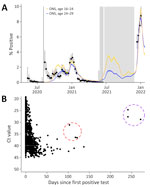Volume 30, Number 9—September 2024
Research Letter
SARS-CoV-2 Dynamics in the Premier League Testing Program, United Kingdom
Abstract
During 2020–2022, players and staff in the English Premier League in the United Kingdom were tested regularly for SARS-CoV-2 with the aim of creating a biosecure bubble for each team. We found that prevalence and reinfection estimates were consistent with those from other studies and with community infection trends.
During the COVID-19 pandemic, frequent SARS-CoV-2 testing regardless of symptoms was used to reduce transmission risk in several workplace populations (1,2). In the process, data from those cohorts generated a range of scientific insights, including estimates of viral shedding dynamics and patterns of immune responses against novel variants of concern. Such testing programs in different settings are valuable for informing planning for future pandemics, especially given likely variation in behavior and therefore risk across subpopulations. Sports testing programs pose a particular challenge for infection control given the potential number of contacts made within and between teams and their support staff.
English Premier League (EPL) fixtures were suspended on March 19, 2020; such events included not only the games but also related social and behavioral aspects, such as fan mingling outside the venues and at concession stands. In May, a strategy was developed to allow games to resume while minimizing transmission risk, including not allowing fan attendance. A key principle of this strategy was a biosecure bubble for each team, which involved SARS-CoV-2 testing of core players and staff twice a week. Initially, PCR testing was used; during June‒November 2021 and from January 2022 on, rapid antigen testing was used for screening (regular PCR was used during the Omicron wave in December 2021), and PCR testing was performed only after a positive rapid test result (Appendix). For this study, we examined PCR test results recorded during May 11, 2020–March 2, 2022.
During the study period, 178,588 PCR tests were obtained from 7,552 unique persons. Throughout late 2020 and early 2021, and during the early stages of the Omicron wave in late 2021, SARS-CoV-2 PCR positivity in the EPL broadly mirrored positivity in the UK Office for National Statistics Community Infection Survey (S. Abbott et al., unpub. data, https://doi.org/10.1101/2022.03.29.22273101) among 16–24- and 25–29-year age groups (Figure, panel A). One exception was early outbreaks in August 2020, as well as a period in early 2021 where prevalence in the EPL program was lower than community prevalence in the Community Infection Survey.
Regular testing can also provide insights into epidemiologic characteristics such as reinfection risk and viral shedding. Several persons recorded positive PCR tests for several weeks after their initial positive test; we identified 1 person with evidence of a reinfection during the Alpha wave (indicated by cycle threshold values >40 after 90 days postinfection) and another 3 persons with evidence of reinfection during the Delta wave (Figure, panel B). Those findings reinforce the importance of effective communication in ensuring appropriate interpretation of results, particularly if persons are being tested regardless of symptoms; a single positive PCR test does not necessarily indicate a recent infection, but a test conducted after symptom onset does. The estimated odds ratio for subsequent infection during the Alpha wave among those infected before December 1, 2020, was therefore 0.1 (95% CI 0.004–0.4), which is broadly consistent with other cohort studies that have estimated ≈85% risk reduction following an initial infection (3). We also found that cycle threshold values at time of first positive test were higher on average during the pre-Alpha period (mean value 33.7, SD 6; n = 106) than during the Alpha wave (mean 29.2, SD = 5.8; n = 223), reflecting the increased shedding for Alpha that has been observed in other studies (S. Funk et al., unpub. data).
In conclusion, we found that SARS-CoV-2 infection prevalence and reinfection estimates among EPL players and staff were consistent with those from other studies and with community infection trends. Such real-time insights could be further enhanced for future outbreaks or pandemics by adding sequencing or antibody testing.
Dr. Kucharski is a professor of infectious disease epidemiology at London School of Hygiene & Tropical Medicine. His research focuses on making better use of data and analytics for understanding infectious disease dynamics, to inform epidemic preparedness and response.
Acknowledgment
S.F., A.J.K., and W.J.E. were supported by funding from the National Institute for Health and Care Research (NIHR) Health Protection Research Unit in Modelling and Health Economics, a partnership between the UK Health Security Agency (UKHSA), Imperial College London, and the London School of Hygiene & Tropical Medicine (NIHR200908). The views expressed are those of the authors and not necessarily those of the UK Department of Health and Social Care, NIHR, or UKHSA. A.J.K. and T.W.R. were supported by a Wellcome Trust Henry Dale Fellowship (no. 206250) and S.F. by a Wellcome Trust Senior Research Fellowship (no. 210758). The Premier League funded the original data collection.
References
- Bailey C, Sanderson T, Townsley H, Goldman J, Black JRM, Young G, et al.; Crick COVID-19 Consortium. Independent SARS-CoV-2 staff testing protected academic and health-care institutions in northwest London. Lancet. 2023;402:21–4. DOIPubMedGoogle Scholar
- Kissler SM, Fauver JR, Mack C, Olesen SW, Tai C, Shiue KY, et al. Viral dynamics of acute SARS-CoV-2 infection and applications to diagnostic and public health strategies. PLoS Biol. 2021;19:
e3001333 . DOIPubMedGoogle Scholar - Hall VJ, Foulkes S, Charlett A, Atti A, Monk EJM, Simmons R, et al.; SIREN Study Group. SARS-CoV-2 infection rates of antibody-positive compared with antibody-negative health-care workers in England: a large, multicentre, prospective cohort study (SIREN). Lancet. 2021;397:1459–69. DOIPubMedGoogle Scholar
Figure
Cite This ArticleOriginal Publication Date: August 14, 2024
Table of Contents – Volume 30, Number 9—September 2024
| EID Search Options |
|---|
|
|
|
|
|
|

Please use the form below to submit correspondence to the authors or contact them at the following address:
Adam Kucharski, London School of Hygiene & Tropical Medicine—Department of Infectious Disease Epidemiology, Keppel St, London WC1E 7HT, UK
Top